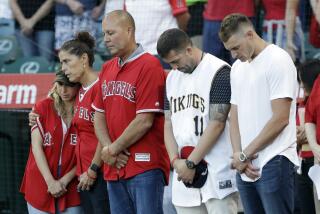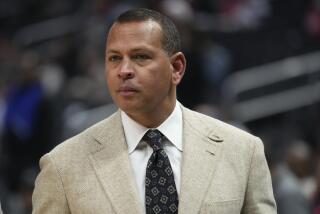History of Drug Tests Is Lengthy
Drug testing in professional sports is a bandwagon that grows more crowded each day.
Long before the National Football League announced its anti-drug program Monday--a program formulated before the cocaine deaths of athletes Len Bias and Don Rogers--officials who run sports were attempting to establish coherent guidelines for monitoring drug abuse.
Amateur sports started doing so in 1976 at the Montreal Olympics with testing for banned drugs in five categories. The National Basketball Assn. was the first professional sport to establish a comprehensive drug testing policy. That program came out of the league’s 1983 collective bargaining agreement, which expires next June.
The NBA policy says that if there is “reasonable suspicion” of drug use, an independent expert (hired under the NBA’s 1984 drug program) can order a test of any player. A player treated for drug abuse three times may be banned from the league for a minimum of two years.
In February, Micheal Ray Richardson, a talented guard for the New Jersey Nets, became the first active player banned by the NBA after testing positive for cocaine. It was the third time Richardson had tested positive for drugs since the agreement was implemented.
One month earlier John Drew, formerly in the NBA and then with the CBA’s Wyoming Wildcatters, became the first player banned under that league’s new drug policy. Drew was barred from returning to the league until at least the 1987-88 season. John Lucas became another drug casualty when he failed a drug test and was dropped by the Houston Rockets in March.
Amid much fanfare, baseball commissioner Peter Ueberroth announced a war on drugs, citing among other reasons, that baseball players serve as role models. Still, baseball has no drug testing policy for major league players. There is some drug testing in the minor leagues and among front-office personnel.
After a parade of professional baseball players testified with immunity about their drug use at a Pittsburgh cocaine-trafficking trials, Ueberroth ordered sweeping changes. In February, he announced the suspension of seven major league players for drug use. The seven, and four others, who faced 60-day suspensions, avoided penalties by agreeing to accept mandatory drug testing, perform community service and donate a portion of their salary to charity. Ten other players agreed to mandatory drugs tests.
And, even as Ueberroth announced the drug problem in baseball is “surrounded,” it was revealed last week that 26 of the 38 Baltimore Orioles have mandatory drug testing clauses in their contracts.
An arbitrator is currently ruling on whether, under the current collective bargaining agreement, owners may institute mandatory testing of players. The commissioner’s office is in favor, but the baseball players’ association believes such testing violates players’ rights.
Hockey has not escaped without its share of drug scandal. In 1978, NHL President John Ziegler suspended Don Murdoch of the New York Rangers for 40 games after Murdoch was convicted of possessing cocaine. In 1982-83, Ric Nattress, then with the Montreal Canadiens and currently with the St. Louis Blues, was suspended 30 games after being convicted of marijuana possession. This spring, published reports claimed several members of the Edmonton Oilers had drug problems.
Ziegler claims that drug use in the league is minimal, but he has joined with Alan Eagleson, executive director of the NHL Players Assn., to recommend a mandatory drug testing program to begin next season.
Problems in pro football first surfaced at an NFL camp held in January to evaluate 335 draft-eligible players. Results of drug testing at the camp revealed 55 college seniors tested positive for cocaine or marijuana use. Twenty-six of the 55 were drafted by NFL teams.
The NCAA, led by university presidents, passed sweeping legislation in January authorizing drug testing at football bowl games and the 74 championship events it sponsors in men’s and women’s sports.
Even with increasing legislation and stepped-up testing, all sides wonder what it will take to solve the problem. Ueberroth agrees that “testing’s not a cure-all,” but he and others in sports are still looking for one.
More to Read
Go beyond the scoreboard
Get the latest on L.A.'s teams in the daily Sports Report newsletter.
You may occasionally receive promotional content from the Los Angeles Times.











